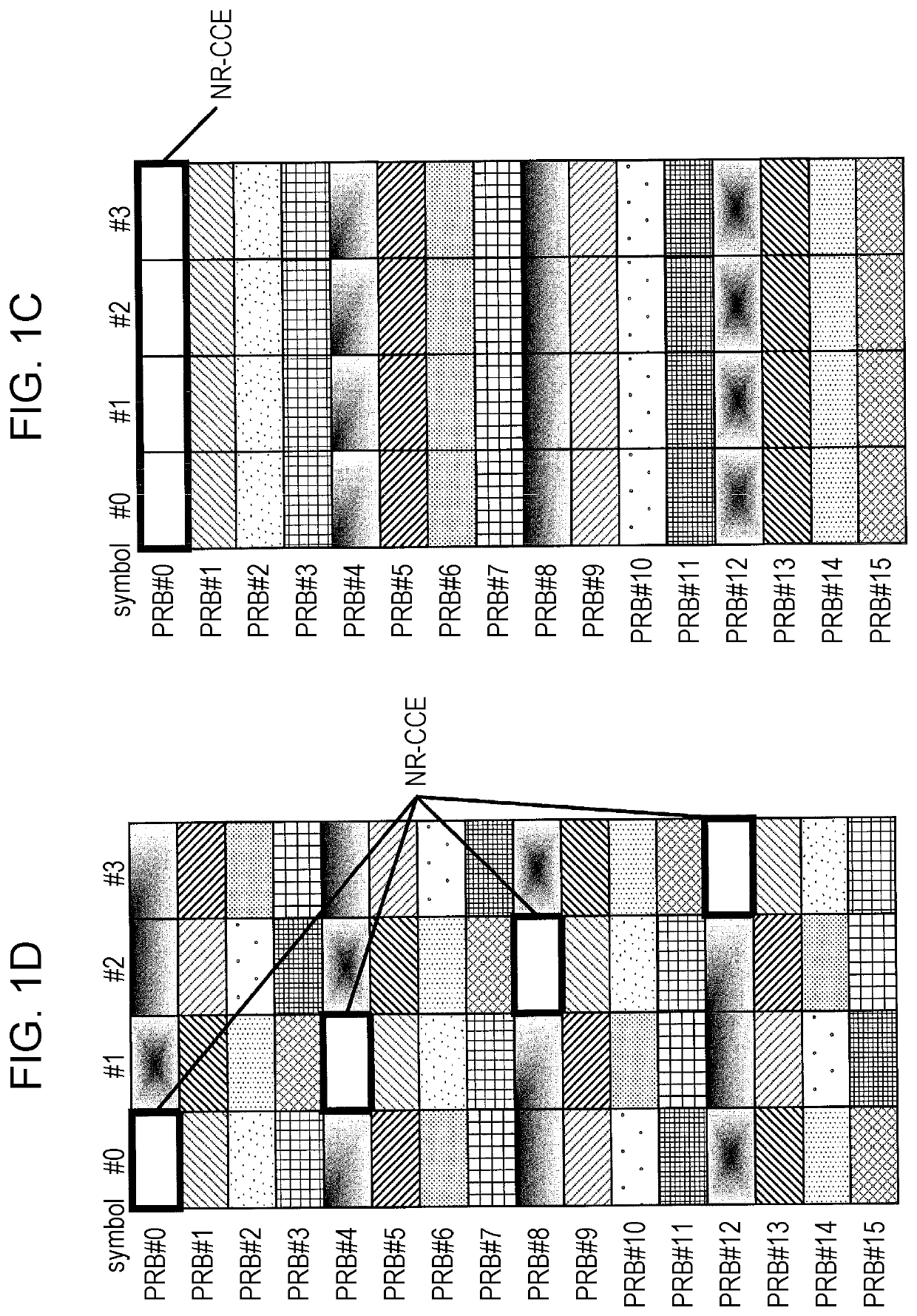Base station, terminal, and communication method
a technology of base station and terminal, applied in the direction of signal allocation, digital transmission, transmission path sub-channel allocation, etc., can solve the problem of not conducting sufficient study on a method for arranging cces (control channel elements)
- Summary
- Abstract
- Description
- Claims
- Application Information
AI Technical Summary
Benefits of technology
Problems solved by technology
Method used
Image
Examples
first embodiment
[0061][Overview of Communication System]
[0062]A communication system according to each embodiment of the present disclosure includes a base station 100 and a terminal 200 (UE).
[0063]FIG. 5 is a block diagram illustrating the configuration of a portion of the base station 100 according to an embodiment of the present disclosure. In the base station 100 illustrated in FIG. 5, a signal allocating unit 105 allocates downlink control signals (DCI) to a control channel region (CORESET) constituted by a plurality of control channel elements (CCEs). A transmitting unit 106 transmits the downlink control signals.
[0064]FIG. 6 is a block diagram illustrating the configuration of a portion of the terminal 200 according to the embodiment of the present disclosure. In the terminal 200 illustrated in FIG. 6, a receiving unit 201 receives downlink control signals (DCI) in a control channel region (CORESET) constituted by a plurality of control channel elements (CCEs). A DCI receiving unit 203 decod...
operation example 1-1
[0097]In operation example 1-1, with respect to a CCE and REG mapping to a CORESET, the number of REGs that constitute a CCE (the number of REGs per CCE) is a power of 2, and the REG bundling size is a power of 2.
[0098]In addition, in operation example 1-1, the number of symbols in which a CORESET is set is a power of 2.
[0099]With such an arrangement, even when the number of symbols in a CORESET set for the terminal 200 differs, mapping of REGs that constitute a CCE in the CORESET becomes common, and the mapping of the REGs becomes simple.
[0100]Also, setting the REG bundling size to a power of 2 makes it easy to perform adjustment when different subcarrier spacings (numerology) are allocated to the same slot or when interference control is performed between cells.
[0101]FIGS. 10A to 10C illustrate REG mapping examples when the number of REGs per CCE is 4 (=22), and the REG bundling size is 2 (=21).
[0102]In FIGS. 10A to 10C, the REG mapping is the time first mapping. That is, REGs tha...
operation example 1-2
[0116]Cases in which the number of symbols in a CORESET is a power of 2 have been described in operation example 1-1. In contrast, a case in which the number of symbols in a CORESET is a value other than a power of 2 will be described in operation example 1-2.
[0117]For example, when the number of symbols in a CORESET is a number of symbols other than a power of 2, REG mapping is set as a reference of REG mapping for the number of symbols which is larger than the number of symbols in a CORESET and which is a power of 2 closest thereto.
[0118]Specifically, when the number of symbols in a CORESET is 3, the last symbol is punctured or rate-matched in REG mapping (see, for example, FIG. 10C) in which the number of symbols is 4 (=22), which is described above in operation example 1-1, to thereby set REG mapping for the symbols in the CORESET, as illustrated in FIG. 13.
[0119]With such an arrangement, the number of REGs that are actually used differs from that in the reference REG mapping, b...
PUM
 Login to View More
Login to View More Abstract
Description
Claims
Application Information
 Login to View More
Login to View More - R&D
- Intellectual Property
- Life Sciences
- Materials
- Tech Scout
- Unparalleled Data Quality
- Higher Quality Content
- 60% Fewer Hallucinations
Browse by: Latest US Patents, China's latest patents, Technical Efficacy Thesaurus, Application Domain, Technology Topic, Popular Technical Reports.
© 2025 PatSnap. All rights reserved.Legal|Privacy policy|Modern Slavery Act Transparency Statement|Sitemap|About US| Contact US: help@patsnap.com



